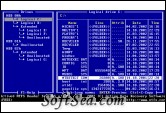|
Active NTFS Reader for DOS 
|
Active NTFS Reader for DOS is a compact and powerful DOS utility that can read NTFS volumes from a DOS environment and copy files and folders to drives having a FAT file system.
Minimum system requirements for Active@ NTFS Reader:
* AT compatible CPU with 286 or newer processor
* 640Kb of RAM
* 1.44 Mb floppy diskette drive
* EGA 640x480 or better screen resolution
* Bootable Floppy disk containing MS-DOS 6.0+, or startup disk for Windows 95/98/ME/XP
* IDE/ATA/SCSI hard drive attached to the system to be recovered
The list below displays the features of Active@ NTFS Reader for DOS:
1. Utility can be saved to and run from a bootable 3.5" floppy
2. Displays complete physical and logical drive information
3. Supports IDE / ATA / SCSI hard drives
4. Supports large sized hard drives (more than 8GB)
5. Reads NTFS, NTFS5 file systems
6. Writes to FAT12, FAT16, FAT32 file systems
7. Supports compressed and fragmented files on NTFS
8. Supports partitions created in MS-DOS, Windows 95/98/ME/NT/2000/XP
9. Displays non-english (local language fonts) and long file names
10. Ability to preview files and folders before copying
11. Supports search by file name or partial file name
12. Disk Viewer displays content of the file in Hex/Text mode
Ideally, create a bootable floppy disk before you encounter any problems with an NTFS
drive. Once you have a bootable floppy, copy or download the utility to the floppy disk.
If you do not have a bootable floppy disk, you can make one from MS-DOS, Windows
95/98/ME/XP following these steps:
MS DOS Prompt
1. Boot the system in MS-DOS or Command Prompt mode.
2. Insert a blank floppy and type the format command in the following syntax: FORMAT A: /S
3. Follow instructions on the screen to complete the process.
WINDOWS 95/98/ME
1. Open the Windows "Control Panel".
2. Click "Add/Remove Programs".
3. Click the "Startup Disk" tab.
4. Click "Startup Disk" and follow screen instructions to complete the process.
WINDOWS XP
1. Boot the system in Windows XP.
2. Insert a blank floppy in the floppy drive.
3. Open Windows Explorer and right-click "A:" drive.
4. Click "Format".
5. Enable the "Create an MS-DOS startup disk" option.
6. Click "Start" to complete the process.
After encountering a problem with an NTFS drive, retrieve your bootable floppy and boot
start the machine from that floppy. Start in DOS mode, or in Command Prompt mode in
Windows 95/98.
Follow the steps below:
1. Start Active@ NTFS Reader for DOS in drive A: by typing: A:\>READNTFS.EXE
2. The NTFS Reader program screen appears.
3. On the left side of the window you will see the list of detected Hard Disk Drives (HDD).
4. HDD Partitions and Logical Drives are displayed in a tree format.
5. Deleted partitions and HDD space not occupied by partitions will be displayed as "Unallocated space".
6. Select drives or folders by using keyboard arrow keys to move the cursor over listed HDD and logical drives. When the cursor is on a particular drive or folder, that drive or folder is considered to be selected. The selected drive or folder information is displayed in the right pane.
Scan drives and folders to locate deleted files. If you know the exact location of the deleted file or folder, you can select that location right away. Use the methods below to scan for deleted files or folders:
1. Select a drive or a folder and press the [Enter] key.
Repeat scanning until you reach the folder where the deleted file or folder is located Deleted files are marked with a solid mark on the left side. NTFS Reader will locate deleted files and folders and does not allow you to preview or copy deleted files.
Search drives and folders if you do not know the exact location of deleted files. Use the search methods below:
1. Select a drive containing files and press [Ctrl+F] on the keyboard. Searching will begin.
2. If you know the exact filename or part of the filename, enter this data in the "Search Dialogue type" and press the [Enter] key. Searching will begin.
3. You can stop the search process at any time by pressing the [Esc] key.
4. If files matching the search pattern are found, the file information is displayed.
5. If displayed file information does not list deleted files that you are looking for, press the [Ctrl+F] keys to continue searching.
6. If displayed file information lists deleted files that you are looking for, press the [Enter] key to stop searching and go directly to the folder where the file was located or press the [Esc] key to cancel further search.
The asterisk symbol (*) is used as a wild card character. Used during the search process, asterisk is replaced by any allowed possible characters available on the system for search purposes.
The question mark (?) symbol is used for single wild card character and is replaced by any allowed possible character available on the system for search purpose.
The license of this software is Freeware, you can free download and free use this data recovery software.
